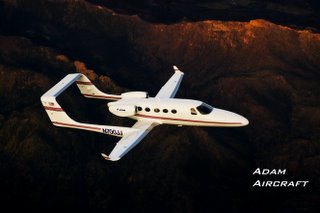Light and fast, they are being touted as a new breed One certification by U.S. regulator expected this winterJan. 2, 2006. 01:00 AM
PETER J. HOWE
BOSTON GLOBEBOSTON—One of the most breathlessly anticipated revolutions in aviation is poised to take off in 2006, as new super-fast, relatively cheap airplanes called ``very light jets" finally go into service.
Thanks to breakthroughs in the performance of engines for small jets, along with better airplane manufacturing techniques, companies like Eclipse Aviation of Albuquerque, N.M., and Adam Aircraft of Denver, Col., are promising a new breed of aircraft for a new category of travel: jet-speed transportation between as many as 5,500 U.S. airports, in planes that cost as little as $1.5 million (U.S.).
That's a fraction of the price of today's private jets.
One crucial innovation behind the Eclipse design is the engine, made by Pratt & Whitney Canada, which thanks to cutting-edge design software and steady advances in technology miniaturization is barely bigger than a washing machine. But it can propel the plane to top speeds of over 430 miles per hour.
Pending final certification by the U.S. Federal Aviation Administration this winter, which is likely, Eclipse's six-seater E500 could take to the skies in July.
A private charter service based at Hanscom Field in Lexington, Linear Air LLC, has already ordered 30 of the Eclipse very light jets and plans to put them in service between August and late 2008. The planes can cruise at over 400 miles per hour, twice the typical speed of private propeller-driven planes.
``This is the absolute future, and everybody in the aviation business knows it," said Arthur Allen, chairman of the Massachusetts Aeronautics Commission, which oversees 38 smaller airports around the state.
Because VLJs weigh as little as a minivan, they can land on runways as short as 3,000 feet — compared to the 4,000 or 5,000 feet required by the smallest private jets today. Allen envisions them opening up new markets for air-taxi and charter services.
"It's like an executive car service, with wings," said Bill Herp, Linear Air's chief executive. ``VLJs are going to revolutionize the way a large percentage of the traveling public gets around.''
Linear currently offers two kinds of service: traditional private point-to-point charter flights, and separate ''scheduled charter by the seat" service that functions like a one-flight-per-day airline between Hanscom and airports in Martha's Vineyard, Nantucket, White Plains, N.Y., and Teterboro, N.J.
Part of Linear's plan with scheduled charter service is to introduce passengers to the private plane experience and convert them to prospective customers for $1,500 or $3,000 charter flights, either for business or vacation travel for affluent consumers, using conventional turboprops now and VLJs in the future.
For Herp, the huge advantage of VLJs is they will cost potentially a third as much to buy and half as much to operate per hour as traditional small jets, vastly broadening the market for air taxi and charter services.
"If you can fly in a private jet for 50 per cent less than the cost of current private jets, there's going to be big demand for that," Herp said.
Richard Jaycobs, who commutes weekly from his home in Nantucket to his job as chief executive of The Clearing Corp., a Chicago financial-services firm, said he thinks VLJs could dramatically change the way he and many other private-aviation passengers travel.
"What I think this will really do is open up a whole new universe of flight possibilities for me and open up private travel service to a lot more people," Jaycobs said.
Typically, he flies from Nantucket to a connecting flight in Boston or Providence. But as he analyzes VLJ costs, Jaycobs said, "a trip from Nantucket straight to Chicago is now possible at a price point that's interesting to me, especially when you couple that with all the hassles of going through the airport.''
Eclipse's financial backers, including Microsoft cofounder Bill Gates Jr., have put $320 million into the company. Last month, it reported orders in hand for 2,357 planes, including 1,592 "firm orders" and option deals for another 765. That represents more than three years of maximum current production capacity. Some of the most zealous evangelists for VLJs have predicted the planes will quickly replace hub-and-spoke misery for high-end business travelers, the lifeblood of commercial airlines, with millions flying in small, comfortable planes from suburb to suburb — paying prices comparable to those for first-class tickets but avoiding big airports entirely.
Others say that even if the potential for VLJs to replace traditional first-class travel is overstated, the planes could still find a big market among the owners of private turboprops who want to upgrade to jets. The jets could be used as air ambulances, for example, or for emergency logistics operations, such as delivering a critical part to a factory to keep a multimillion-dollar production line operating.


